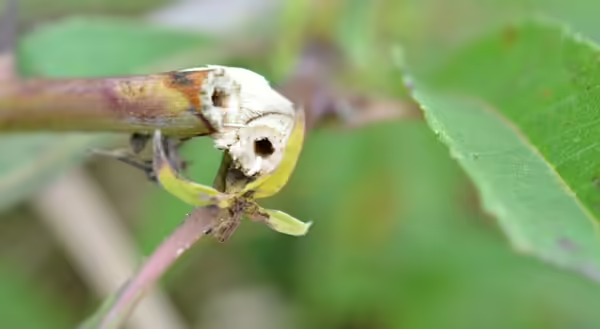
As the winter chill thaws, gardeners erupt with excitement for the big botanical blitz that is spring.
We scan the aftermath of winter and spot the evidence of last year’s gardening efforts in our brown landscapes: dried plant stems, partially mulched leaves, and hints of green - our emerging spring bulbs.
Beware, lovers of wildlife and pollinators, do not clean up your winter-killed landscape too soon.
Insects in various stages of life use our gardens to overwinter; some winter as adults, while others seek refuge as larvae or eggs.
The best rule of thumb for spring cleanup:
Do not clear or cut back plant material until temperatures are consistently above 50 degrees overnight. These warmer temperatures will stimulate insect activity, including eggs to hatch, larvae to emerge and butterflies or moths, cleverly mimicking plant parts, to erupt from their camouflaged chrysalis.
An ecosystem of pollinators seek refuge in every garden. Modify your cleanup to keep them around.
A silvery checkerspot butterfly may be seeking refuge in your garden at this moment. As brown-skinned caterpillars, the species overwinters at the base of its host plants: black-eyed Susan, coneflower, and sunflower. Caterpillars that matured by the end of last season are likely seeking refuge too. If you spot a chrysalis, attached to, or near the stem of these host plants, it will need to remain undisturbed to ensure development of the small orange butterflies covered in black lines, patches, and spots.
In addition to butterflies, various species of bees, including carpenter bees, overwinter in the pith of stems. In the early spring, as the bees wake up and seek suitable stems for nesting, their presence can be encouraged by gardeners cutting the tips of stems which opens the stem for easier entry. To encourage spring egg laying, cut stems back to a height of 12-18 inches.
Snipped-off foliage, which will still be harboring some nesting bees, should be chopped into large chunks and spread around the garden, instead of being composted. In late spring, dead stems could be cut to the ground, but if left in place, new foliage will cover these dead stems and your garden will become a year-round haven to the bees. Spring clean-up that consists of cutting down and removing materials suitable for cavity-nesting disrupts the 30 percent of native bees that nest above-ground. When cleaning up your garden this season, consider leaving plant stems which are favorites for native bees: asters, goldenrods, thistles, bergamot, black-eyed Susan, and coneflowers.
The rest of our native bees are overwintering in the ground and will emerge when spring weather warms. Delay spring mulching which inhibits the emergence of wonderful spring-flower pollinators.
PHOTO CREDIT: Bee Nesting in Sunflower Stem; Erin Garrett, University of Illinois Extension
ABOUT THE AUTHOR: Kelly Allsup is a Horticulture Educator for University of Illinois Extension serving Livingston, McLean and Woodford Counties. She meets the educational needs of her community, including local chapters of Master Gardener and Master Naturalist volunteers, through expertise in home horticulture and entomology. Her passion for ecologically-friendly gardening and all things plants makes her a dynamic speaker on topics that range from beneficial insects, growing vegetables and fruits, to urban trees.